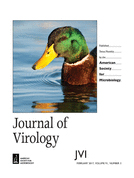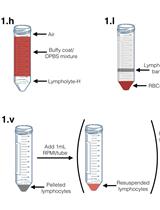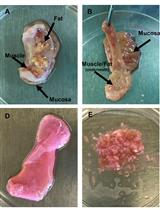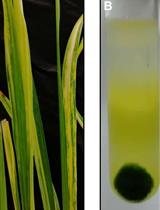- EN - English
- CN - 中文
Alphavirus Purification Using Low-speed Spin Centrifugation
低速旋转离心纯化甲病毒
发布: 2018年03月20日第8卷第6期 DOI: 10.21769/BioProtoc.2772 浏览次数: 11386
评审: Dennis NürnbergKathrin SutterJia Meng
Abstract
Chemical and sedimentation procedures are used to purify virus particles. While these approaches are successful for wild-type viruses, they are often not feasible for purifying mutant viruses with assembly defects. We combined two published methods (Atasheva et al., 2013; Moller-Tank et al., 2013), to generate a protocol that uses low-speed centrifugation to purify both wildtype and mutant enveloped virus particles at high yield with minimal handling steps. This protocol has successfully been used to purify alphavirus particles for imaging and structural studies (Wang et al., 2015; Ramsey et al., 2017).
Keywords: Enveloped virus purification (包膜病毒纯化)Background
Virus purification is traditionally based on chemical precipitation (e.g., PEG) or density gradient centrifugation. Centrifugation protocols involve pelleting particles at high speeds (> 100,000 x g) or through sedimentation matrices such as cesium, Nycodenz, Iodixanol, sucrose, glycerol, or tartrate. After sedimentation in the gradient, the purified virus sample usually requires additional steps to remove the gradient matrix, concentrate the purified particles, and buffer exchange into a stabilizing buffer for downstream applications. These approaches include dialysis, centrifugation through a centrifugal filter, or PEG precipitation. While these approaches will produce purified particles, there are several drawbacks: (1) overall yields can be low, (2) time required for the purification can extend to a week, (3) morphologically heterogeneous particles are not purified with equal efficiency, (4) particles can be damaged in the process, and (5) assembly mutants often do not survive the purification process making certain downstream analyses challenging.
The protocol described here uses a gentle approach to purify enveloped virus particles. We used minimal centrifugal force to reduce damage to particles which is observed as increased morphological heterogeneity in negative-stain transmission electron microscopy (TEM) or total loss of fragile particles by TEM or infectivity assays. In addition, we wanted to reduce the manipulation of purified virions post-purification. By merging two protocols from the literature (Atasheva et al., 2013; Moller-Tank et al., 2013), we are able to purify different Alphaviruses (Sindbis [Ramsey et al., 2017], Ross River [Wang et al., 2015], Chikungunya [Mukhopadhyay and Wang, unpublished data] and assembly mutants of each) via low-speed centrifugation (LSC). No additional steps for gradient matrix removal, sample concentration, or buffer exchange are necessary. We are also able to use this protocol to purify viruses from different cell lines (mammalian and arthropod). These purified particles have been used for cryo-EM, mass spectrometry, and protease cleavage studies.
Materials and Reagents
- Pipette tips
Note: Filter tips are not necessary unless you routinely use when working with your virus of choice. - 150 mm cell culture dishes (Greiner Bio One International, catalog number: 639160 , or equivalent)
- Sterile polypropylene 50 ml conical tubes (Corning, catalog number: 430921 , or equivalent)
- Serological pipets, 5 and 10 ml (DWK Life Sciences, KIMBLE, catalog numbers: 56900-5110 and 56900-10110 , or equivalent)
- Kimwipes (KCWW, Kimberly-Clark, catalog number: 34155 , or equivalent)
- Cotton swabs (Ted Pella, catalog number: 80907 , or equivalent)
- pH test strips (Hach, catalog number: 2601300 )
- EM grids Formvar/Carbon 300 mesh (Ted Pella, catalog number: 01753-F )
- BHK-21 cells (ATCC, catalog number: CCL-10 )
- C6/36 cells (ATCC, catalog number: CRL-1660 )
- 1x sterile PBS (Corning, catalog number: 21-040-CM , or equivalent)
- Coomassie blue
- Page Ruler Prestained Protein Ladder (Thermo Fisher Scientific, Thermo ScientificTM, catalog number: 22616 )
- MEM media (Corning, catalog number: 15-010-CV , or equivalent)
- 100x L-glutamine (Corning, catalog number: 25-005-CV , or equivalent)
- 100x MEM nonessential amino acids (Corning, catalog number: 25-025-Cl , or equivalent)
- 100x antibiotic-antimycotic (Corning, catalog number: 30-004-Cl , or equivalent)
- FBS (Corning, catalog number: 35-010-CV , or equivalent)
- Sterile virus production serum free media (VP-SFM) (Thermo Fisher Scientific, GibcoTM, catalog number: 11681020 , or equivalent)
- HEPES (Fisher Scientific, catalog number: BP310-1 , or equivalent)
- Sodium chloride (NaCl) (Fisher Scientific, catalog number: BP358-10 , or equivalent)
- Ethylenediaminetetraacetic acid (EDTA) (Sigma-Aldrich, catalog number: EDS-100G , or equivalent)
- Hydrochloric acid (HCl)
- Uranyl acetate (Electron Microscopy Sciences, catalog number: 22400 , or equivalent)
- MEM complete media (see Recipes)
- Supplemented VP-SFM (see Recipes)
- HEPES-NaCl-EDTA (HNE) Resuspension buffer (see Recipes)
- 1% uranyl acetate (see Recipes)
Equipment
- Pipettes
- Tissue culture incubator, temperature and CO2 regulated (Thermo Fisher Scientific, Thermo ScientificTM, model: Forma 3130 , or equivalent)
- Refrigerated table-top centrifuge with fixed angle rotor (Eppendorf, model: 5804 R , with F34-6-38 rotor, or equivalent)
- Biosafety cabinet (Thermo Fisher Scientific, Thermo ScientificTM, model: 1300 Series Class II, Type A2 , catalog number: 1323TS, or equivalent)
- Adjustable tilt rocker (Reliable Scientific, model: 55 rocking shaker )
Procedure
文章信息
版权信息
© 2018 The Authors; exclusive licensee Bio-protocol LLC.
如何引用
Rayaprolu, V., Ramsey, J., Wang, J. C. and Mukhopadhyay, S. (2018). Alphavirus Purification Using Low-speed Spin Centrifugation. Bio-protocol 8(6): e2772. DOI: 10.21769/BioProtoc.2772.
分类
微生物学 > 微生物细胞生物学 > 细胞分离和培养
细胞生物学 > 细胞分离和培养 > 细胞分离
您对这篇实验方法有问题吗?
在此处发布您的问题,我们将邀请本文作者来回答。同时,我们会将您的问题发布到Bio-protocol Exchange,以便寻求社区成员的帮助。
提问指南
+ 问题描述
写下详细的问题描述,包括所有有助于他人回答您问题的信息(例如实验过程、条件和相关图像等)。
Share
Bluesky
X
Copy link













